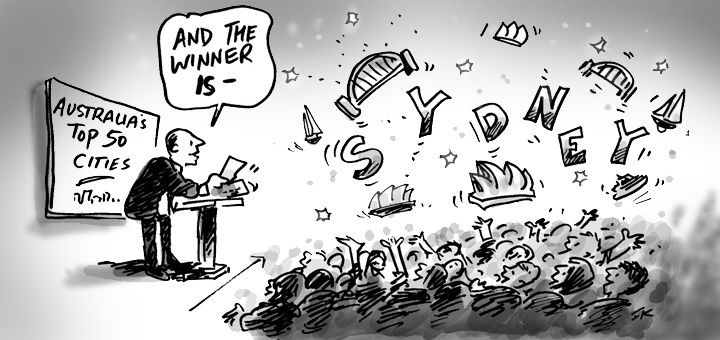BLOG
What is Australia’s fastest growing inland town?
What is Australia’s fastest growing inland town?
This was a question put to me by one of our forecast clients recently, and it did intrigue me. After all, there’s so much attention on the growth of our major cities and coastal areas, that population trends in inland areas are almost an after thought. They are however very real and relevant to councils in our inland regions, so I thought it was worth addressing the question – what is our fastest growing inland town?
Geography issues – again
Of course it all depends on how you define a “town”, or even “inland”. The ABS does have a handy Urban Centres and Localities (UCL) classification in their geography structure, and this is the obvious starting point as it generally measures the built up area, whereas a spatial unit like a postcode or SA2 may include surrounding areas, or cut across towns. The table below shows the largest inland towns (UCLs) in Australia at 2011 – of course as our national capital it’s no surprise that Canberra is ranked first.
| Rank | UCL name | State | 2011 population |
|---|---|---|---|
| 1. | Canberra | ACT | 355,596 |
| 2. | Toowoomba | QLD | 96,567 |
| 3. | Ballarat | VIC | 85,935 |
| 4. | Bendigo | VIC | 82,794 |
| 5. | Launceston | TAS | 74,085 |
| 6. | Maitland | NSW | 67,132 |
| 7. | Rockhampton | QLD | 61,724 |
| 8. | Bundaberg | QLD | 49,750 |
| 9. | Wagga Wagga | NSW | 46,913 |
| 10. | Albury | NSW | 45,627 |
Source: ABS, Census of Population and Housing (2011)
Note that if you include Albury-Wodonga as one entity, then it’s 2011 population is 77,232, which puts it slightly ahead of Launceston. But then you’d also have to include Queanbeyan as part of Canberra – which it is in an urban sense as development is contiguous. Geography is never straightforward!
It’s also worth noting that I’ve defined inland as those UCLs that do not have a boundary abutting the coast, but I do accept that some of those I’ve considered in this analysis are influenced by their relative proximity to coastal areas.
In light of the changes in the geography structure implemented by the ABS in 2011, the boundaries of the UCLs are generally not comparable between 2006 and 2011. This makes it difficult to determine by how much and how fast UCLs are growing. However I’ve included a table below which indicate which towns (populations over 10,000) have grown the most between the 2006 and 2011 Censuses, mainly because it does contain some surprises.
| Rank | UCL name | State | Population growth 2006-2011 | Rank | UCL name | State | Annual average growth 2006-2011 | |||
| 1. | Canberra | ACT | 33,560 | 1. | Pakenham | VIC | 11.8% | |||
| 2. | Pakenham | VIC | 14,107 | 2. | Gympie | QLD | 9.6% | |||
| 3. | Melton | VIC | 9,684 | 3. | Melton | VIC | 4.9% | |||
| 4. | Ballarat | VIC | 7,714 | 4. | Mount Barker | SA | 4.6% | |||
| 5. | Bendigo | VIC | 6,743 | 5. | Nambour | QLD | 3.7% | |||
| 6. | Gympie | QLD | 6,354 | 6. | Gawler | SA | 3.7% | |||
| 7. | Maitland | NSW | 5,701 | 7. | Emerald | QLD | 3.2% | |||
| 8. | Shepparton | VIC | 3,968 | 8. | Warragul | VIC | 2.6% | |||
| 9. | Gawler | SA | 3,951 | 9. | Murray Bridge | SA | 2.6% | |||
| 10. | Sunbury | VIC | 3,496 | 10. | Lara | VIC | 2.5% |
Source: ABS, Census of Population and Housing (2006 and 2011)
It’s of no surprise that the larger UCLs tend to have the largest growth, on account of their inbuilt population and economic momentum. Some may be surprised to see Pakenham and Melton on this list, as they are essentially outer suburbs of Melbourne. It is a quirk of the UCL classification that these types of areas appear because their urban development is non-contiguous with the rest of the metropolitan area – for example there is still a wide gap between Caroline Springs and Melton, though the gap between Pakenham and Beaconsfield is disappearing as Officer becomes developed.
In terms of the fastest growing towns, the rapid growth of Pakenham in recent years puts it at the top of the list. However I did have reservations about including Gympie at all because the boundary in 2011 covers a much larger area than that of 2006, hence the rather large increase in their population. Mount Barker, located just outside of Adelaide on the eastern side of the Mount Lofty ranges, can possibly lay claim to being the fastest growing inland town in Australia as it’s population increased by 4.6% per annum between 2006 and 2011, on the basis that it is not yet part of the Adelaide metropolitan areas (though very much within its social and economic influence) and the 2006 and 2011 boundaries are roughly similar.
Due to geographic changes implemented by the ABS the only real way of measuring the fastest growing inland towns is to standardise their geography so that they are on comparable boundaries. One of the major benefits of profile.id is that we do this – small area boundaries are standardised on their 2011 boundaries and the differences in geographic boundaries accounted for in the statistics. Unfortunately profile.id does not have Australia wide coverage, so we can only show partial results. It should also be noted that small area boundaries are based on gazetted localities, and are not the same boundaries as ABS UCLs.
| Rank | Small area | 2006 population | 2011 population | Annual average growth rate 2006-2011 |
|---|---|---|---|---|
| 1. | Pakenham (suburb) | 19,660 | 33,976 | 11.2% |
| 2. | Gympie | not available | ||
| 3. | Melton Township | 36,259 | 46,220 | 5.0% |
| 4. | Mount Barker – Wistow & District | 10,485 | 12,265 | 3.2% |
| 5. | Nambour Activity Centre | 13,430 | 14,996 | 2.2% |
| 6. | Gawler | not available | ||
| 7. | Emerald Town | 11,160 | 13,222 | 3.4% |
| 8. | Warragul – Warragul West | 12,178 | 13,906 | 2.7% |
| 9. | Murray Bridge and East Side* | 13,749 | 15,876 | 2.9% |
| 10. | Lara ABS State Suburb | 12,850 | 14,264 | 2.1% |
* combined total of two small areas – Murray Bridge, and East Side
Source: profile.id
The fastest growing towns as measured by the UCLs on the whole show similar results when small areas are considered. Pakenham (suburb) recorded very rapid growth between 2006 and 2011. This of course is consistent with the development of new greenfield estate on the edge of town – effectively the expansion of the Melbourne metropolitan area to the south east. Melton Township also grew rapidly which again is not surprising as it is part of Melbourne’s expansion to the west. Of actual towns, Mount Barker – Wistow & District showed lower growth when measured as a small area, but was still amongst the highest rates recorded at 3.2% per annum. The main difference was the Nambour Activity Centre which had a lower growth rate than that recorded by the UCL, possibly because it does not include Woombye.
So what does this mean in the end, and what is Australia’s fastest growth inland town? Well, it’s very much dependent on what spatial unit is measured, and how comparable it is over time. Personally I think that the spatial units should be comparable over time, and that they should be meaningful. From a role and function perspective, Pakenham and Melton are outer suburbs of Melbourne, not country towns. I prefer to compare spatial units as presented in profile.id but discount what are essentially part of larger metropolitan areas. This suggests that the outback Queensland town of Emerald and the South Australian town of Mount Barker are the fastest growing towns in Australia….as measured by the Census usual residence counts in 2006 and 2011.
Simone - Myth Buster
Simone has a rich background in human geography, demography and urban planning – a background that was useful in her previous roles in the Commonwealth and State Governments, and now as part of the forecast team at .id. From the Queensland coast to the southern suburbs of Perth, Simone produces population and dwelling forecasts that help local governments make informed decisions about future service and planning needs. She is a regular contributor to .id’s blog and has spoken at several conferences on how our cities and regions are changing. She is a big advocate of evidence-based planning and how Census and other data can inform this. Outside of work Simone is a keen traveller and photographer – interests that tie in well with her professional life and help her to understand “place”.










